Key takeaways:
- Character development involves exploring a character’s backstory, motivations, and internal conflicts to create relatable and compelling narratives.
- Effective character arcs anchor the plot and resonate with readers, often addressing broader societal themes and emotions.
- Utilizing tools like character sketches, questionnaires, and visual boards can deepen a writer’s understanding and connection to their characters.
- Common challenges in character development include ensuring authenticity in growth, balancing flaws with likability, and managing the pacing of transformations.
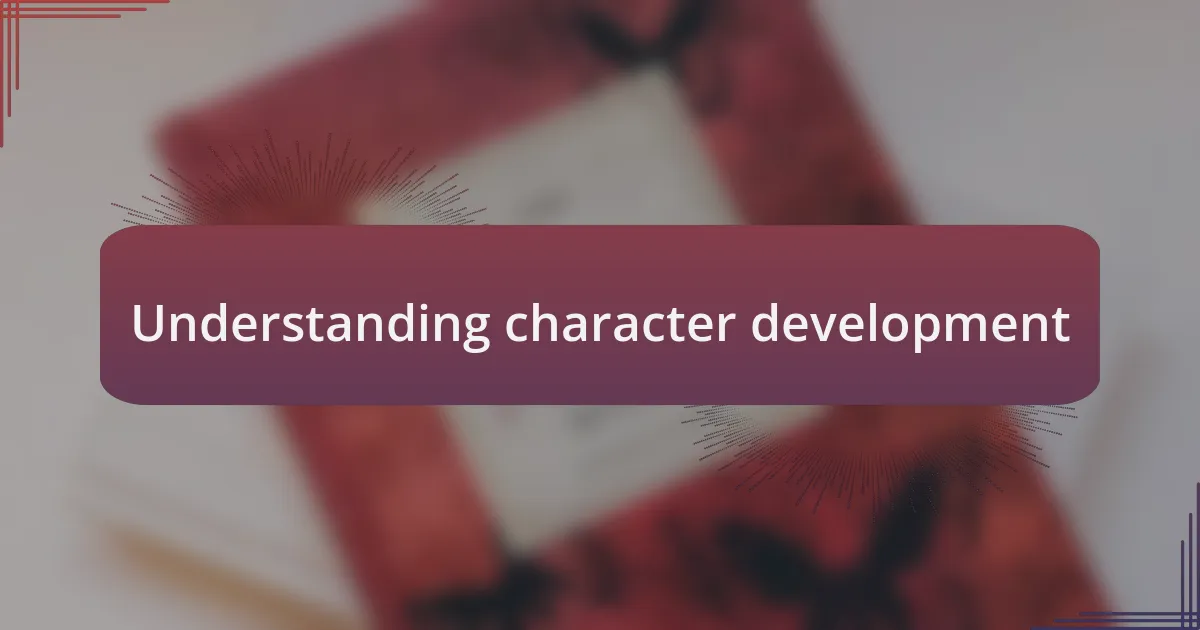
Understanding character development
Character development is a fascinating process that allows a writer to breathe life into their creations. I remember a time when I was struggling to define my protagonist’s motivations. By delving into their backstory, I discovered layers of conflict and desire that not only shaped them but made them relatable to my readers. Isn’t it incredible how a well-thought-out character can evoke strong feelings and connections?
Every character journey mirrors the complexities of real-life experiences. I often reflect on the growth arcs of characters I admire; they seem to embody struggles we all face. Consider how a character faces failure—don’t you find that inspiring? They might falter, but it’s in their resilience and eventual triumph that we see the essence of true development. I think that’s what keeps readers turning the pages.
Understanding character development also means being aware of how external influences shape an individual. In my own writing, I’ve found that placing characters in challenging situations reveals their true selves. It’s like looking into a mirror—how do we react under pressure? This kind of exploration not only deepens the story but also resonates with those who share similar challenges, making the narrative all the more compelling.
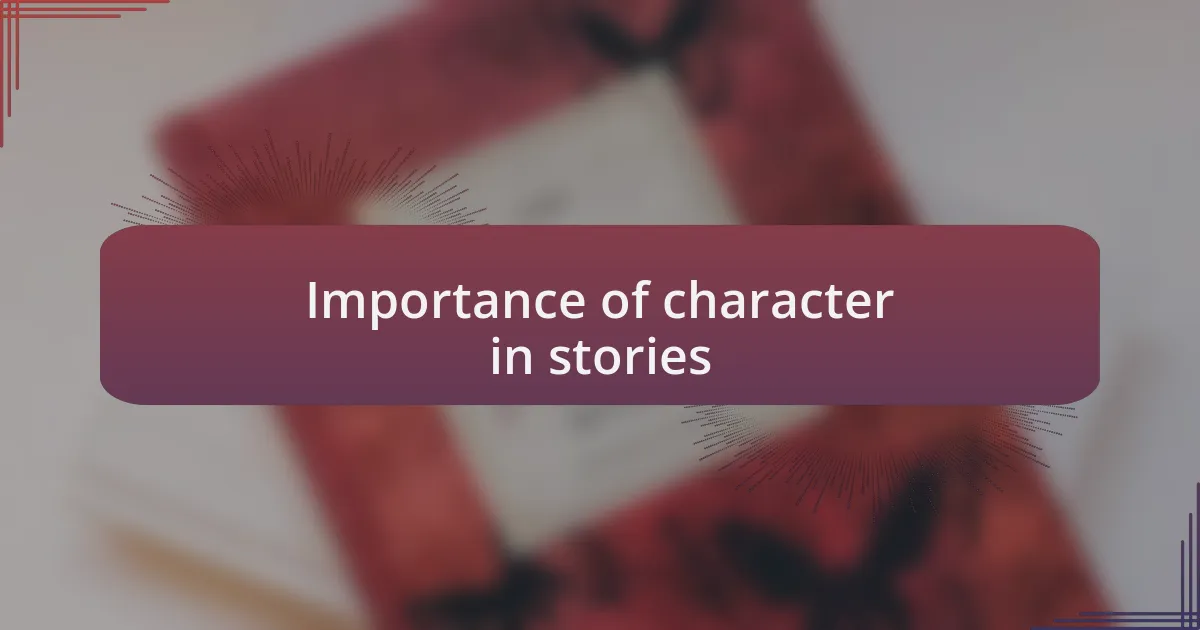
Importance of character in stories
Characters are the heartbeat of any story, and their importance cannot be overstated. I vividly recall a time when I connected with a protagonist who struggled with self-doubt. As I turned each page, I found fragments of myself reflected back, and it made me realize how deeply character-driven narratives can resonate with readers. Have you ever felt that surge of empathy for a character? It’s this emotional connection that draws us into their world.
Moreover, characters anchor the plot and theme, guiding readers through the narrative journey. In one of my own stories, I realized that without a well-crafted character arc, my plot felt aimless. When a character undergoes transformation, it elevates the entire narrative, making it memorable. Isn’t it fascinating how a single character can turn a simple tale into a profound exploration of human experience?
I also believe that authentic characters spark conversations about larger societal issues. When I wrote a character grappling with societal expectations, it opened up dialogues with readers about identity and belonging. This connection can lead to deeper reflections, pushing readers to reconsider their perceptions. Isn’t it inspiring how a fictional character can influence real-world thoughts and feelings?
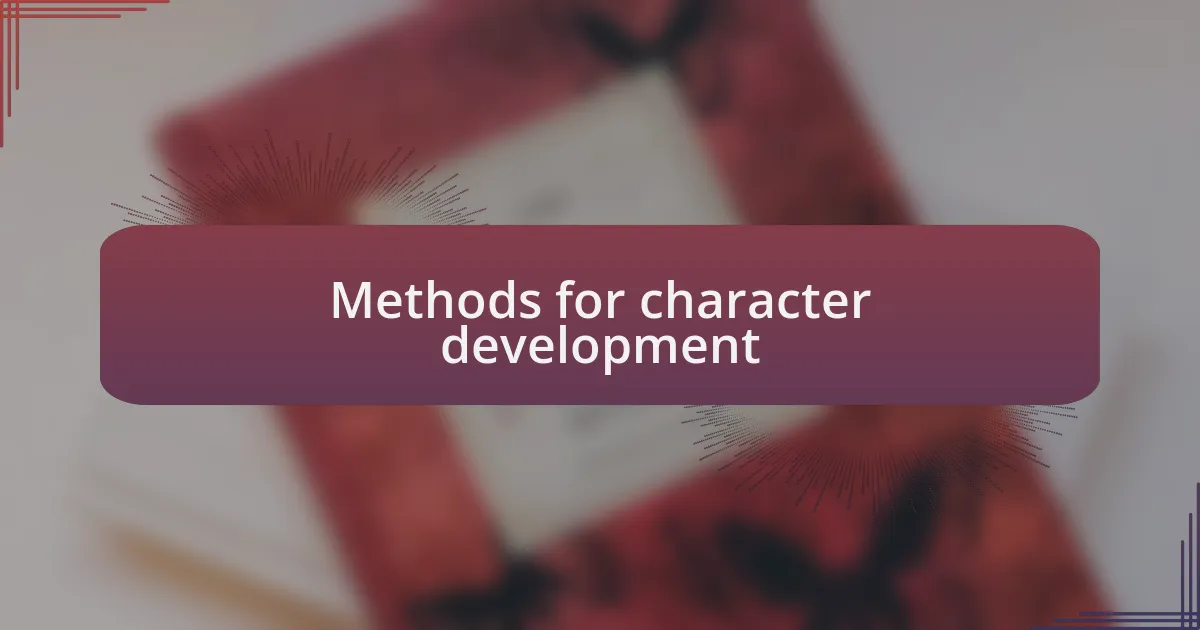
Methods for character development
When it comes to character development, one method I swear by is creating detailed character profiles. I dive into their backgrounds, motivations, and quirks, ensuring that I understand who they are at their core. For example, when I was fleshing out a character who was a musician, I spent hours researching the struggles and triumphs of real artists. This research not only added authenticity but also deepened my emotional connection to the character.
Another effective technique I’ve employed is writing scenes from the characters’ perspectives, even if they don’t end up in the final draft. This practice allows me to explore their thoughts and emotions in a visceral way. I remember writing a scene where my character faced a moral dilemma. Putting myself in their shoes made it easier to capture the tension and uncertainty they felt, helping to create more relatable moments on the page.
Finally, feedback from beta readers offers invaluable insights into character development. I once shared a draft where a character was meant to be introspective but ended up coming off as aloof. The honest input helped me see how minor adjustments could enhance their relatability. Don’t you find it fascinating how others’ perspectives can illuminate aspects of a character you might overlook? Embracing this collaborative approach not only enriches your characters but also deepens the reader’s engagement with them.
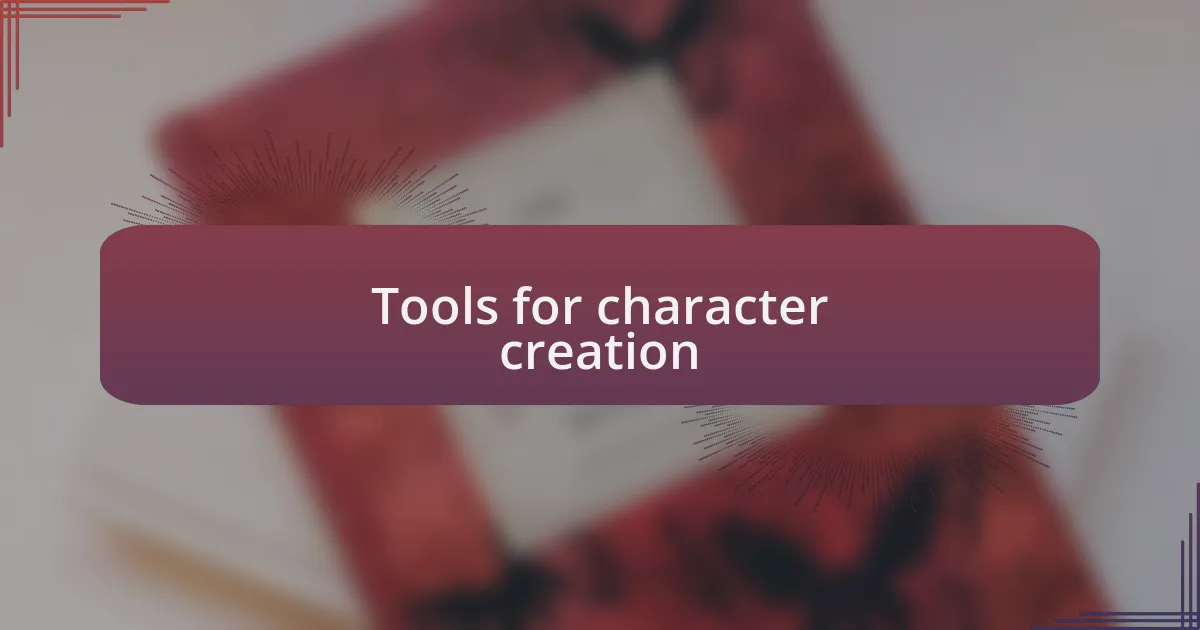
Tools for character creation
When it comes to tools for character creation, I have found that character sketches work wonders for bringing my ideas to life. These sketches serve as a quick reference, capturing the essence of a character in just a few sentences. For instance, I once sketched a character who was a reluctant hero, jotting down key traits and emotional scars that shaped him. This simple tool helped me maintain focus on his journey throughout the story.
Another invaluable tool I’ve used is a character questionnaire. This method involves answering a series of targeted questions about a character’s background, dreams, and fears. I remember sitting down one evening with a cup of tea, answering questions for a character who was a single parent. The process not only revealed her resilience but also unearthed deeper layers of vulnerability. It surprised me how much more I understood her, leading to moments in the story that truly resonated emotionally.
Finally, I often create visual boards or collages for my characters. There’s something transformative about collecting images that encapsulate their personalities and traits. I recall piecing together a mood board for a character who was a passionate environmental activist; it made her aspirations feel tangible. Have you ever tried creating a visual representation of your characters? It can deepen your connection to them and inspire fresh narrative ideas in ways you might not initially anticipate.
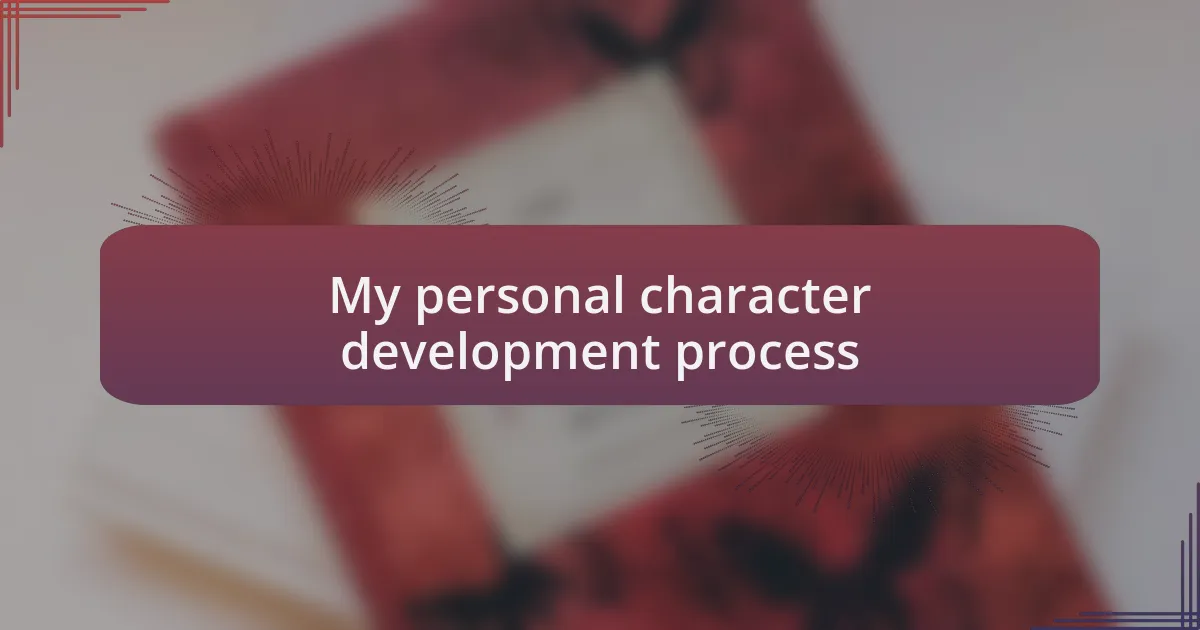
My personal character development process
When I think about my personal character development process, the first step always involves digging deep into my character’s psyche. I remember the excitement I felt when I first fleshed out a character’s internal conflict—discovering her struggle between ambition and family loyalty. That moment of realization not only made her more relatable but also helped me craft scenes that highlighted her complexities. Have you had a character that challenged your own beliefs? This kind of exploration can lead to the richest narratives.
Another vital aspect of my process is brainstorming potential arcs and transformations. I often find myself jotting down ideas during quiet moments, perhaps while sipping my morning coffee. One morning, I brainstormed a redemption arc for a character who was grappling with guilt. Suddenly, the notion of forgiveness sprouted from my page, and I found myself emotionally invested in her journey toward self-acceptance. How often do we allow our characters to reflect our personal struggles and triumphs?
Lastly, I immerse myself in my character’s world through writing prompts or freewriting sessions. This technique allows me to explore different scenarios, often revealing unexpected traits and motivations. I vividly recall a session where I allowed my character to face a moral dilemma—her choice unveiled surprising courage that I hadn’t anticipated. It’s fascinating how such exercises can lead to clarity in character development. What’s your go-to method for unlocking your character’s potential?

Successful examples of character development
Exploring successful examples of character development often brings to mind iconic figures in literature. One character who stands out for me is Elizabeth Bennet from “ and Prejudice.” Her growth from a prejudiced young woman to someone who acknowledges her own shortcomings truly resonates. I often find myself asking whether we allow our characters to evolve in ways that challenge societal norms. Elizabeth’s journey prompts me to examine how my characters can confront their biases and emerge stronger.
Another remarkable example is Walter White from “Breaking Bad.” His transformation from a mild-mannered chemistry teacher into a ruthless drug lord is haunting yet brilliant. I remember analyzing his descent, realizing how his initial motivations stemmed from desperation and love for his family. Have you ever had a character whose choices made you question your moral compass? Walter’s challenging path forces me to reflect on the darker aspects of human nature in my writing.
Then there’s Katniss Everdeen from “The Hunger Games,” whose character arc embodies resilience and sacrifice. I recall feeling exhilarated as she faced life-threatening challenges, learning how her choices impacted not only her but also those she loved. How often do we consider the ripple effects of our characters’ decisions? Katniss’s journey reminds me that a character’s development can shape the very world they inhabit, adding layers of depth to the narrative.
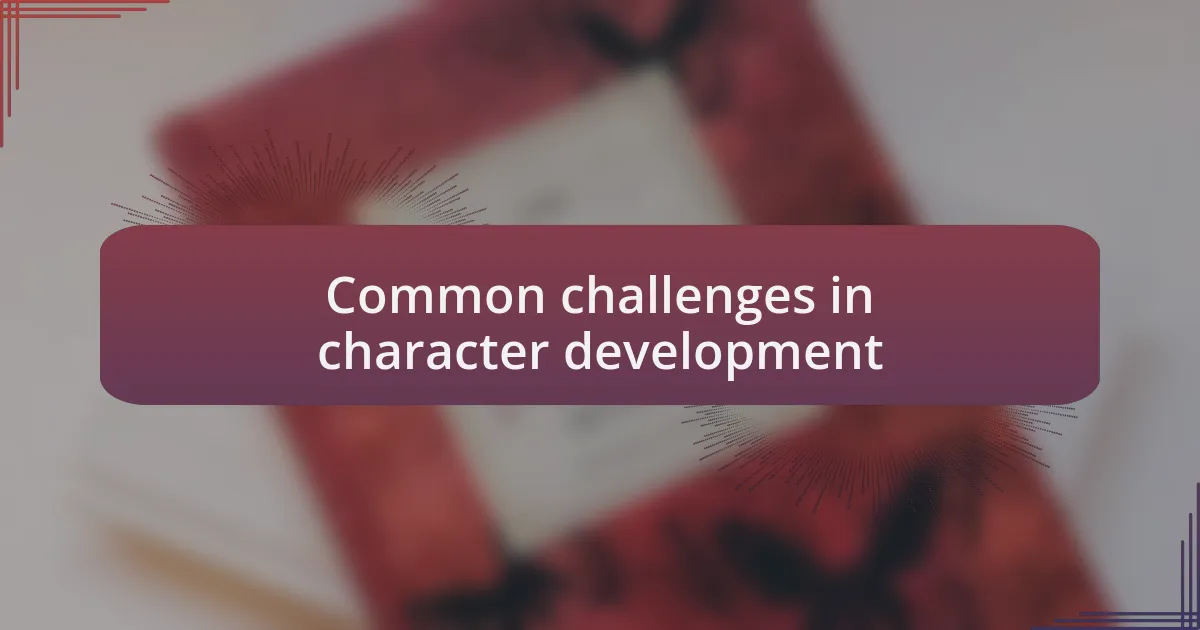
Common challenges in character development
Character development is a multifaceted challenge that many writers grapple with. One common hurdle is ensuring that a character’s growth feels authentic and relatable. I often find myself flipping through drafts, questioning whether my characters’ transformations resonate with real-life experiences. Have you ever felt that a character’s change seemed forced or unrealistic? It’s a crucial reminder to anchor their journeys in emotional truth.
Another difficulty arises when trying to balance character flaws with growth. I’ve struggled with creating characters that are flawed but still likable—finding that sweet spot can be tricky. I sometimes wonder if readers can truly connect with characters who don’t show vulnerability. This interplay between strengths and weaknesses can make or break a character’s development, and navigating that balance can be an ongoing battle.
Lastly, pacing character development presents another hurdle. I recall a story where I rushed my protagonist’s growth, only to realize later how disjointed it felt to the reader. Have you ever had that moment where you realized a character went from one extreme to another without enough build-up? I’m learning that gradual changes can provide a more satisfying and believable arc, allowing readers to savor the journey alongside the character.